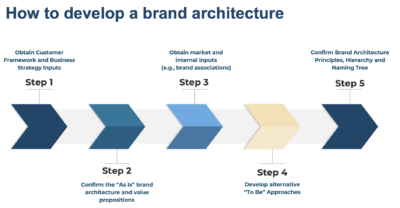Managing Brand Architecture
Managing Brand Architecture for Clarity and Control
 A brand architecture strategy is only effective if it can be clearly understood, easily adopted, and actively managed over time. At EquiBrand, we help clients move from concept to execution by designing governance models and tools that align brand structure with long-term business strategy.
A brand architecture strategy is only effective if it can be clearly understood, easily adopted, and actively managed over time. At EquiBrand, we help clients move from concept to execution by designing governance models and tools that align brand structure with long-term business strategy.
Whether you’re managing dozens of sub-brands or streamlining after an acquisition, a thoughtful and well-managed architecture creates clarity for both customers and internal stakeholders.
1. Conducting a Brand Portfolio Audit
We begin by assessing the current brand landscape. This includes:
-
Reviewing your existing brands, sub-brands, product lines, and naming conventions
-
Mapping internal brand relationships and customer-facing perceptions
-
Analyzing the equity of each brand—both emotional and financial
-
Identifying overlaps, redundancies, and missed opportunities
The audit serves as the foundation for strategic decisions and helps create a shared understanding across teams.
2. Defining Brand Architecture Principles
A clear brand structure requires guiding principles. These provide guardrails to ensure consistency while allowing for flexibility as the portfolio evolves.
Examples include:
-
Limit new brand creation unless justified by clear strategic value
-
Prioritize clarity over internal org structure
-
Use sub-branding only when differentiation is essential to customer choice
-
Align brand hierarchy with customer decision flow
These principles are customized based on your category, competitive context, and brand goals.
3. Exploring Brand Hierarchy Alternatives
With a clear audit and set of principles, we develop and evaluate 3–5 brand hierarchy models. Each option outlines how brands relate and how naming conventions and brand roles are assigned.
Common models include:
-
Branded House: One master brand with descriptive product names (e.g., FedEx Express, FedEx Ground)
-
House of Brands: Independent brands under a holding company (e.g., P&G, Unilever)
-
Hybrid or Endorsed Models: Combination of masterbrand and independent brand elements (e.g., Marriott Bonvoy endorsing sub-brands)
We compare options across business alignment, brand equity impact, and customer clarity.
4. Developing a Brand Naming Decision Tree
To bring structure to future naming decisions, we create a tailored decision tree. This tool answers questions like:
-
Should this be a new brand, sub-brand, or product name?
-
Does it require independent positioning or can it leverage the masterbrand?
-
How do we handle co-branded offerings or internal product lines?
The decision tree ensures consistency across teams and markets while reducing decision-making friction.
Putting Brand Management Into Practice
We bring brand architecture to life through:
-
Interactive work sessions using brand architecture templates and frameworks
-
Collaborative mapping exercises with stakeholders
-
Codified brand playbooks for ongoing governance
-
Roadmaps for rollout, communication, and cross-functional alignment
The result is a brand system that not only reflects your strategy, but also guides decision-making at every level of your organization.
When to Reassess Your Brand Architecture Management
We typically help clients manage and optimize brand architecture during:
-
Post-merger or post-acquisition integration
-
Expansion into new markets or categories
-
Internal confusion around naming, branding, or brand roles
-
Leadership or marketing team transitions
-
Declining brand clarity or marketing efficiency
Frequently Asked Questions
What is a brand architecture audit?
A brand architecture audit is a comprehensive review of your current brand portfolio. It evaluates each brand’s strategic role, customer clarity, and performance—both from an emotional equity and financial perspective.
What’s the benefit of establishing brand principles?
Brand principles serve as internal guidelines for managing your architecture over time. They ensure consistency across divisions, reduce decision-making friction, and help new teams or leaders understand how the brand system is structured.
How do I choose the right brand hierarchy model?
We help clients evaluate 3–5 brand hierarchy options based on clarity, brand equity, internal alignment, and go-to-market efficiency. The right model balances business needs with customer experience—whether that’s a branded house, house of brands, or a hybrid system.
When should we revisit our brand architecture?
Typical trigger points include:
-
Mergers or acquisitions
-
Launching new categories or services
-
Customer confusion about brand structure
-
Internal misalignment across product teams
-
Leadership or marketing transitions
What is a brand naming decision tree?
A brand naming decision tree is a customized tool that helps teams decide when to use the masterbrand, create a sub-brand, or develop a new brand. It standardizes naming decisions across teams and ensures consistency as the portfolio grows.
Let’s Bring Structure to Your Brand Portfolio
EquiBrand can help you manage brand architecture not just as a static framework—but as a living system that supports growth, clarity, and consistency.
















Follow EquiBrand